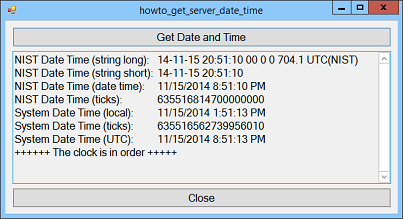
Title: Get the current time from the NIST server in C#

This example, courtesy of Adam Benson, shows how you can get the current time from the NIST atomic clock server. (I've reformatted it slightly to make it fit better on the blog page.)
The key to the program is the following method, which does the work of getting the date and time.
//Server addresses and information from //http://tf.nist.gov/tf-cgi/servers.cgi
public const string server = "time.nist.gov"; //URL to connect to the server
public const Int32 port = 13; //port to get date time data from the server
//**************************************************************************
//NAME: GetNISTDateTime
//PURPOSE: Creates a TCP client to connect to the NIST server, gets the
//data from the server, and parses that data into a string that can be used
//for display or calculation.
//**************************************************************************
public void GetNISTDateTime()
{
bool bGoodConnection = false;
//Create and instance of a TCP client that will connect to the server
//and get the information it offers
System.Net.Sockets.TcpClient tcpClientConnection = new System.Net.Sockets.TcpClient();
//Attempt to connect to the NIST server. If it succeeds, the flag is set
//to collect the information from the server If it fails, try again
try
{
tcpClientConnection.Connect(server, port);
bGoodConnection = true;
}
catch
{
btnGetServerDateAndTime.PerformClick();
}
//Don't continue if you haven't got a good connection
if (bGoodConnection == true)
{
//Attempt to get the data streaming from the NIST server
try
{
NetworkStream netStream = tcpClientConnection.GetStream();
//Check the flag the states if you can read the stream or not
if (netStream.CanRead)
{
//Get the size of the buffer
byte[] bytes = new byte[tcpClientConnection.ReceiveBufferSize];
//Read in the stream to the length of the buffer
netStream.Read(bytes, 0, tcpClientConnection.ReceiveBufferSize);
//Read the Bytes as ASCII values and build the stream
// of charaters that are the date and time from NIST.
sNISTDateTimeFull = Encoding.ASCII.GetString(bytes).Substring(0, 50);
//Convert the string to a date time value
try
{
subStringNISTDateTimeShort = sNISTDateTimeFull.Substring(7, 17);
dtNISTDateTime = DateTime.Parse("20" + subStringNISTDateTimeShort);
}
catch
{
//try running the sub again if you didn't get anything worth while
btnGetServerDateAndTime.PerformClick();
}
}
else //If the data stream was unreadable, do the following
{
//Advise the user of the situation
MessageBox.Show("You cannot read data from this stream.");
tcpClientConnection.Close(); //close the client stream
netStream.Close(); //close the network stream
}
//Uses the Close public method to close the network stream and socket.
tcpClientConnection.Close();
}
//Provide the user feedback if the TCP client couldn't
// even get the stream of data from the server.
catch (ArgumentNullException e)
{
// show error messages when appropriate
MessageBox.Show("ArgumentNullException: {0}", e.ToString());
}
catch (SocketException e)
{
// show error messages when appropriate
MessageBox.Show("SocketException: {0}", e.ToString());
}
}
}
The code attempts to make a TCP client connection to the server. If it makes the connection, the code gets a stream to read data from the connection. If the stream is readable, the program reads bytes from it. It then uses the Encoding.ASCII.GetString method to convert the bytes into a string. The result is a string of the form:
\n56444 13-06-01 16:03:24 50 0 0 385.7 UTC(NIST) *
Here the "\n" at the beginning is an embedded newline character.
The code uses this string's Substring method to pull out the date and time information in the following format:
13-06-01 16:05:48
The rest of this method's code is error handling.
After finding the subStringNISTDateTimeShort string, the program uses the following statement to convert it into a DateTime value.
dtNISTDateTime = DateTime.Parse("20" + subStringNISTDateTimeShort);
The program then displays the date and time in various formats.
|
There's one more important piece to the program. Before it requests the date and time from the NIST server, the program starts a timer. The program won't access the server again until the timer expires 5 seconds later. This prevents the program from hitting the NIST server very quickly. If you flood the server with requests, it will ban you and stop replying.
|
Download the example to experiment with it and to see additional details.
|
![[C# Helper]](../banner260x75.png)

![[Beginning Database Design Solutions, Second Edition]](db2_79x100.png)
![[Beginning Database Design Solutions, Second Edition]](db2_79x100.png)